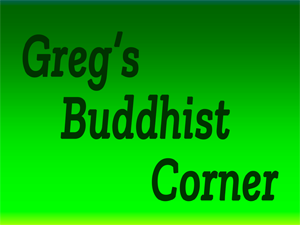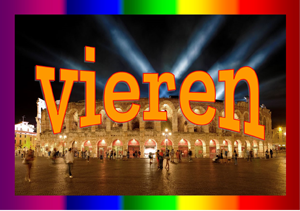And what is a Lama anyway? The story of the Lama for lay people…
By Greg Suffanti
QFWF no. 12, August 2019
Lamas lighten heavy burdens, llamas carry them
I’ve been a Buddhist for about twenty years and a volunteer at a local Buddhist center for nearly just as long. I live near the center (Maitreya Instituut in Amsterdam) and have a guest room, so I frequently host visiting Tibetan Lamas who are teaching at our center.
Through the years, more often than not, when I say,
“I’m hosting a Lama this weekend?”
I get a puzzled look from my non-Buddhist friends. I explain that I don’t mean the animal sort of llama, but the person sort.
When my editor here at the WW raised a question about the meanings of the titles of Lama, Geshe, Rinpoche and the title Kyabje, I thought a little background information would do a world of good for anyone interested in or curious about Tibetan Buddhism.
I imagine more than one person has overheard me talking about my impending Lama visit and wondered where on earth I kept all these llamas in Amsterdam?!
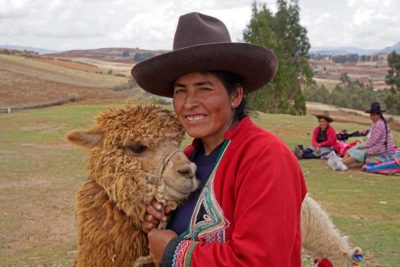
A Lama normally refers to an accredited teacher or highly respected practitioner of Tibetan Buddhism, and a llama refers to an herbivore mammal originating from South America.
Llamas can live at high altitudes and have been bred and cultivated for thousands of years as a beast of burden, a supplier of fresh meat, and like its cousin the alpaca, a provider of the raw material wool.
Llamas, like alpacas, belong to the camel family Camelidae[1].
Lamas used to be mostly of Tibetan origin, but there are a few Westerners who’ve recently graduated earning the Geshe degree, to which the title of Lama is attached. More on this later.
Unlike a llama, who is used to carrying heavy burdens, Lamas are considered experts at lightening the heavy burdens of life.
The llama has appeared in the 21st century as a cute, cuddly, and irresistable household decoration
Most recently, the llama has appeared as a cute, cuddly and irresistable 21st century household decoration at stores around the world, its image on everything from hand towels to finger puppets to coasters to lamps and stuffed animals.
The only similarity I can think of between a Lama and a llama, besides the fact that their names sound the same, is that some llamas live at high altitudes, and some Tibetan Lamas used to as well; but that was before China’s 1959 invasion of Tibet, which chased the Lamas en masse to exile in India, at decidedly lower altitudes than Tibet.
So much for that theory!
Both the Lama and the llama have a reputation as generally easy going and agreeable
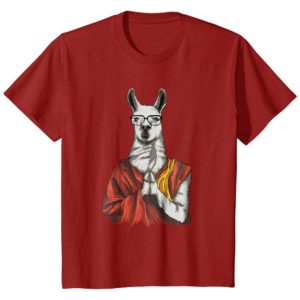 Both Lamas and llamas do seem to share a reputation as being generally easy going and agreeable, which perhaps explains why Lamas like His Holiness (HH) the Dalai Lama have become so popular in the West with Buddhists, and llamas so desirable as household pets with those seeking something more exotic than a goldfish or puppy.
Both Lamas and llamas do seem to share a reputation as being generally easy going and agreeable, which perhaps explains why Lamas like His Holiness (HH) the Dalai Lama have become so popular in the West with Buddhists, and llamas so desirable as household pets with those seeking something more exotic than a goldfish or puppy.
I mean, if you’re really reaching for a comparison. Is it possible that the popularity of the Dalai Lama has positively influenced the pet craze of the llama? I’ve seen t-shirts with llamas dressed like Buddhist Lamas. The mind reels.
Just like Lamas and llamas sometimes get confusing, llamas and look-alike alpacas are also often confusingly difficult to separate as two distinct species. And they can even crossbreed! However, alpacas are considerably smaller than their cousin the llama.
Now that we’ve established the difference between a Lama and a llama (and even a llama and an alpaca), we need to answer the basic question of ‘what is a Lama anyway’?
Tibetan Buddhism is propagated through the system of the Lamas
According to the Collins Dictionary, “a Lama is a Buddhist priest or monk”[2]. While the Cambridge Dictionary says that a Lama is “a title given to a Tibetan Buddhist spiritual teacher” [3]. Lama is also an Arabic word that means “nice lips and nice face” [4].
For the record, all Lamas are not monks. Lamas who are not ordained may marry.
Let’s be clear about that. And “Lama” is a title found in Tibetan Buddhism, not in Theravada Buddhism.
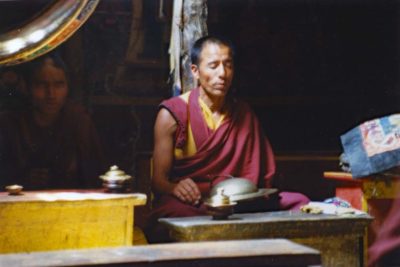
There are many “Tulkus”, who are considered reincarnations of previous Lamas, and are therefore accorded the title of “Lama” upon recognition and validation by a senior Lama, such as HH the Dalai Lama.
These Tulkus, just like senior Lamas given the title of Rinpoche, meaning “precious one”, can marry and have children when not ordained as a monk.
And yes, you can be a Tulku and a Lama and a Rinpoche all at the same time.
Gomo Tulku Rinpoche, for example.
“Priest” is more similar in meaning to the title “Venerable”, which is used in the West for all Tibetan Buddhist monks and nuns as a prefix to their name.
Ven. Kaye Miner, for example. Further, not all Lamas and Rinpoches and Tulkus teach, so the Cambridge definition lacks in a bit of clarity as well.
Lamas in the West are often Geshes, who’ve achieved a doctor degree at a Buddhist university
In the Gelugpa School, one of four schools of Tibetan Buddhism, the title of Lama is accorded to an individual who has successfully completed an educational program at an accredited Tibetan Buddhist university.
The program typically lasts between 17-25 years, and earns the graduate the title of “Geshe”, which is synonymous with the title “Lama”.
The degree is a doctorate in Buddhism. Many of the Lamas teaching in the West today are Geshes. This includes HH the Dalai Lama.
In 2011, the first female Geshe, Geshe Kelsang Wangmo, a German native, became the first woman to earn Tibetan Buddhism’s highest degree.
In the Nyingma, Kagyu and Sakya lineages, a monk or nun may also earn the title ‘Lama’
In the other three schools of Buddhism, the Nyingma, Kagyu and Sakya schools, a monk or nun or someone considered an advanced practitioner can receive the title of Lama.
This is not possible in the Gelugpa tradition.[5]
Tibet preserves the Nalanda Tradition in its entirety, which is unique
Buddhism is alive today thanks in large part to Tibet. More accurately, Buddhism is alive today because the Nalanda tradition from ancient India, which has faded from India, has been preserved through the caretakers of Tibetan Buddhism, who have preserved it in its entirety.
This is why Tibet and Tibetan Buddhism are considered so special, according to HH the Dalai Lama.
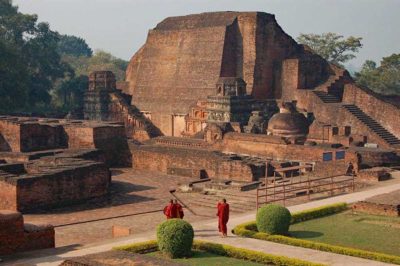
Since the Chinese invaded Tibet and slaughtered tens of thousands of innocent people in 1959, and simultaneously destroyed thousands of monasteries as well, these preservers of the Nalanda Tradition now mostly live in exile in India.
Tibetan Buddhism continues largely now from India, and continues today through the system of the Lamas, who propagate the teachings of Buddhism around the world. The most well-known Lama in the world today, is HH the Dalai Lama, who has traveled and taught extensively in lands around the world for more than 40 years.
The Panchen Lama was kidnapped by the Chinese at age 6 and never again seen
HH the Dalai Lama is considered the 14th reincarnation of the Dalai Lamas, which were the temporal and spiritual leaders of Tibet since the middle ages, until the 1959 invasion.
His Holiness retired as leader in exile of the Tibetan people in 2011. His Holiness is still considered the official spiritual head of Tibetans and many Tibetan Buddhists of non-Tibetan descent consider him the spiritual head of Tibetan Buddhism as well.
The Panchen Lama, second in spiritual authority to HH Dalai Lama, was kidnapped in 1995 at the age of six by Chinese authorities, three days after HH the Dalai Lama had identified him as the reincarnation of the previous Panchen Lama. He has never been seen again. The Chinese have subsequently installed an imposter as the current Panchen Lama, in the hopes of asserting his power and authority after the death of the current 84 year old Dalai Lama. This is significant as about half of the worlds estimated 500,000,000 Buddhists are Chinese[7].
The Four Schools of Tibetan Buddhism and the Lamas who head the lineage/school
Gelugpa or Gelug School
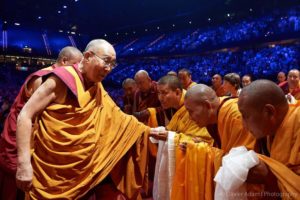
Most people assume that HH the Dalai Lama is the head because he is from the Gelug School. However, the head is an appointed 7 year term, and is called the Ganden Tripa.
Lama Je Tsongkhapa founded the Gelug school and was its first Ganden Tripa. Jangtse Choejey Kyabje Jetsun Lobsang Tenzin Palsangpo is the current Ganden Tripa. And yes, he is considered a Lama as well. The word “Kyabje” is a title reserved for the most respected and senior of Lamas. Kyabje means “lord of refuge”.
Nyingma School
Traditionally there wasn’t a head of the Nyingma lineage. After the 1959 Chinese invasion, the Central Tibetan Authority requested the position. The position is filled on a three year rotating basis among the six principle Nyingma lineage holders[8].
Kagyu School
The Kagyu lineage emphasizes oral instructions passed directly from the teacher to his disciple. Tilopa (988-1069) was the first Karyu teacher. The Karmapas head the Kagyu School. The current Karmapa, born in 1985, is Ogyen Trinley Dorje, and he tours the world teaching the Dharma[9].
Sakya School
The Sakya Trizins head the Sakya lineage. Like the Karmapas, His Holiness (HH) the Sakya Trizins have been great, traveling teachers of Buddhism is the 20th and 21st centuries. According to His Holiness’s website, His Holiness Kyabgon Gongma Trichen Rinpoche served as the head until March of 2017, when the duties were handed over to the 42nd Sakya Trizin, His Holiness Ratna Vajra Rinpoche[10].
Titles that let you know the individual is also a Tibetan Lama
|
His Holiness |
Used in other religions as well, denoting a very high religious level or position |
|
His Eminence |
Also used in other religions, denoting a very high, senior position |
|
The Sakya Trizin |
Head of the Sakya lineage |
|
The Karmapa |
Head of the Kagyu lineage |
|
The Ganden Tripa |
Head of the Gelug lineage |
|
Dorje Pakmo |
The highest female incarnation in Tibet and 3rd in authority after the Dalai Lama and the Panchen Lama |
|
Khenpo or Khen |
The title of the Abbott of the monastery |
|
Khensur |
The title given to the retired Abbott |
|
Kyabje |
“Lord of Refuge” |
|
Rinpoche |
meaning “precious one” |
|
Geshe |
Doctorate of Buddhism |
|
Tulku |
Reincarnation of a previous Lama |
|
Lama |
Note
The Sanskrit word ‘Guru’ has not appeared anywhere in this article. That is because the word most often means spiritual guide, and does not necessarily mean that the guide is a Lama! Or even a Buddhist for that matter.
One last piece of advice…
The dying words of the Buddha were,
“Don’t believe what I say is true just because I’m the Buddha.
Find out the truth of my teachings for yourself!”
This is important in this day and age of spiritual consumerism, when charlatans market Buddhism as a commercial product, and unethical, charismatic Lamas take advantage of people looking for something to believe in. The word ‘Lama’ is simply that…. A word.
Early 20th century scholars described the Tibetan Buddhist system of Lamas as “lamaism”. This was a pejorative term based on a lack of understanding.
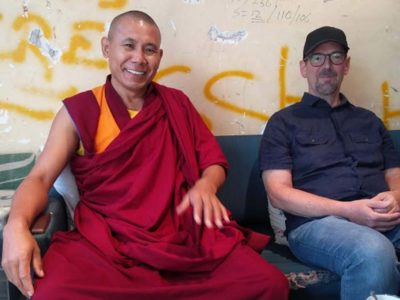
To the unknowing, it can appear as though people are blindly following and openly worshipping someone with the title of Lama, or any of its various combinations from the list above.
Of course, some students do follow Lamas blindly, and some unscrupulous Lamas have gained notoriety in the last couple of decades for crimes ranging from theft, to torture and rape.
At the end of the day, a title is meaningless if, upon further inspection, the individual is seen to be worthless.
I asked Geshe Rinchen, currently teaching at our center, what he thought about all these terrible stories of these supposedly high and important Lamas who’d destroyed people’s live with their criminal behavior. He said,
“It’s the students’ fault for not carefully examining and investigating the teacher thoroughly!”
Caveat emptor! … “Let the buyer beware!”
Notes:
[1] www.newworldencyclopedia.org/entry/Llama
[2] www.collinsdictionary.com/dictionary/english/lama
[3] dictionary.cambridge.org/dictionary/english/lama#
[4] www.urbandictionary.com/define.php?term=Lama
[5] See below for an explanation of the four schools and their Lama leaders
[6] Source: Nalanda University
[7] en.wikipedia.org/wiki/Buddhism_by_country
[8] en.wikipedia.org/wiki/Nyingma#Hierarchy_and_teachers
[9] kagyuoffice.org/kagyu-lineage
[10] www.hhsakyatrizin.net

